How to beat match
The complete guide to beat-matching and why it’s a skill you still need
Nearly every piece of DJ hardware these days has a sync button on it. The art of beat matching has been perfecting by one simple button.
Or has it? The answer is a big fat NO!
Yous seriously need to learn how to beat match even in 2025 and here’s why.
Read my complete guide to beat matching, exactly what it is, why you need to be able to it, techniques and tricks to make it easier.
So lets get stuck in!
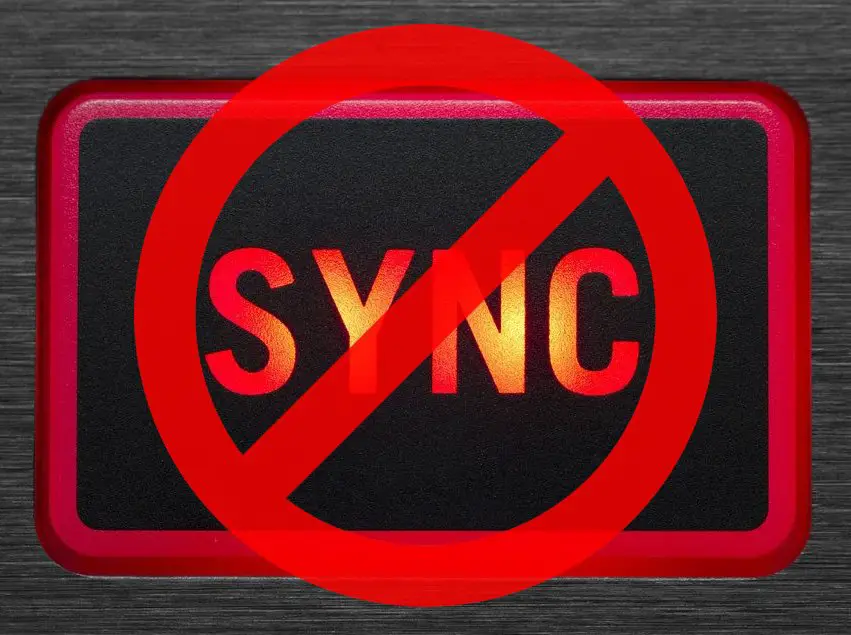
- The basics of beat matching
- Why you still need to beat match in 2022
- Finding tracks that compliment each other
- Making life easier by picking tracks with similar BPMs
- How to beat match quickly
- Refining the beat match
- Avoiding the Sync button
- Beat matching Vinyl
- Beat matching with controllers
- Beat matching with a laptop
- Why good headphones are important for beat matching
- Why good monitors are important for beat matching
Lets just double check we all know exactly what beat matching is and what it involves.
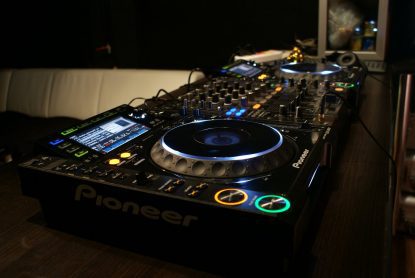 In order to create a smooth and seamless mix between two tracks of any genre you first need to make the tempos of both tracks match. Usually by speeding up or slowing down the tempo of the track you want to introduce in to a mix.
In order to create a smooth and seamless mix between two tracks of any genre you first need to make the tempos of both tracks match. Usually by speeding up or slowing down the tempo of the track you want to introduce in to a mix.
You do this by adjusting the speed of the track until both sound perfectly in tune. Depending on the genre this will mean the kick drums of both tracks hit at the same time, or the percussion loops of the 4 beat format on both tracks is perfectly aligned.
Can you hear this in action?
Well no. Actually you hear the opposite!
You can hear when its not working well. When the tempos are out of phase and the two songs are not in sync with each other. You’ll hear a nasty clash of kick drums, percussion all over the place, it’ll sound a huge mess!
When you’re doing right you almost wont be able to distinguish one track from another, when you transition the mix between the two it’ll sound sweet and complimentary, assume the two tracks sound vaguely similar.
The better you can beat match the more seamless you’ll be able to mix and the less work you’ll need to do when DJing. A good beat-matcher will be able to get two tracks sync-ed pretty quickly and keep them there with minimal effort, allowing the DJ to be creative with loops, effects and filters. Or simply be less stressed when behind the decks in front of an adoring crowd!
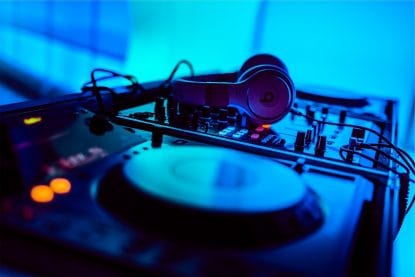 So you may be asking why would you want to add a potential stressful situation to your DJ-ing? If a simple sync button can stop the stress of trying to beat match why go to the trouble of learning how to beat match?
So you may be asking why would you want to add a potential stressful situation to your DJ-ing? If a simple sync button can stop the stress of trying to beat match why go to the trouble of learning how to beat match?
There’s one very simple reason and its crucial that every DJ realise this!
The sync feature will fail you. It is inevitable.
Yes my friend no sync button is perfect. No piece of software has perfected the art of finding the exact tempo of tracks. Sure it does a pretty good job a lot of the time but mark my words, it will get wrong from time to time. It will mess up and here’s a bunch of reasons why it can.
- Misunderstanding the percussion and giving a false BPM reading
- Half or double tempo readings on tracks with unusual kick drums
- Picking up the first beat of the track from the wrong place
- Getting confused by the intro to the track and mistaking a different sound as the kick drum
- Getting confused when a track changes tempo
- Play tracks that are not quantised / not perfect tempo throughout (often happens with indie, rock, some pop, acoustic)
This is just a handful of the issues that the sync feature faces when trying to work out what BPM your music is. There’s plenty more reasons it can and will fail at some point.
So what are you going to do when this happens? What skills do you have to take over where this automated process left off and make sure your mix isn’t ruined?
Learn to beat match! That’s how!
Don’t worry everything you need to know is right here.
Lets make life easy for you and start with something that will take away some of the complexities. You can work up to those later.
Firstly you’ll want to two tracks that are nice and simple. No overly complex percussions, no sounds that will mask the audio “markers’ that make beat matching easy.

For this I recommend just finding a track with a simple kick drum and high hat percussion around 120 BPM, loop a 16 bar section and just leave it playing. If you’re playing with CDs or vinyl play a track with a long simple lead in section or lead out. One you can easily play for a good minute or so and skip back to the start with ease if looping isn’t an option.
This is your target, you want to try and get another track to match this one. To make life easy find another song you have which has a similar minimalist kick drum and high hat sound to it. Nothing too layered or complex. Just a nice simple 4 beat arrangement that is close to the first track.
Listen to both of these sections of both tracks. Listen to how the kick drums, high hats, claps and symbols differ. Make sure you can identify the sounds of both tracks. This is key to knowing whether your tracks are in sync with each other and what you need to do to keep them that way
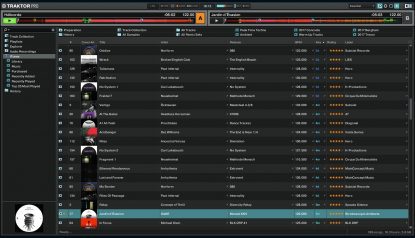 Now let’s get a bit more technical. You can of course get super creative and beat match hip hop to drum and bass, the latter having twice the BPM of the former, but its not easy!
Now let’s get a bit more technical. You can of course get super creative and beat match hip hop to drum and bass, the latter having twice the BPM of the former, but its not easy!
You can also change a 120 BPM track to meet one of 130BPM but generally if they differ that much they are different musical styles or genres which will make life more difficult.
Keep things simple. Find two tracks that are within 5 BPM of each other. so 120BPM and 125 BPM or less. If you’re in to funky or deep house you’ll find most tracks are within this range. Similarly with drum and bass you’ll find most are around 165 – 175BPM
Don’t pick 2 tracks with exactly the same BPM! That’s way too easy to beat match (although will still take a little skill to sync manually).
Make sure the pitch fader on your decks or controller are set to +- 8% range. This will give you plenty of accuracy to play with when adjusting the tempo in tiny amounts. If you’ve got it set to 50% or something crazy like that it’ll be almost impossible to perfectly beat match. Make your life easy and keep to the standard 8%.
You also want to make sure you’re only ever playing with positive numbers. Music never sounds good slowed down, it adds a feeling of lethargy and dullness to music so make sure your primary track (we’ll call it track A) is the faster of the 2 and the track you want to bring in (we’ll call it track B) is the slower.
So if Track A is 123 BPM the track B’s natural BPM should be slower at 120, so that we can speed up track B to match track A.
Slowing down a track from 123BPM to 120 BPM wont sound anywhere near as good as speeding up the slower track to meet the faster BPM. Keep that in mind when picking your set list. There’s a full article on how to create the best setlist here.
Track A is playing for all to hear, you want to get Track B to the right speed as soon as possible, so you have plenty of time to refine the speed and decide when is best to perform you r mix.
So this section is all about getting there quickly.
Here’s some handy tips and techniques for beat matching quickly.
Move the pitch fader proportionately to the difference in tempos
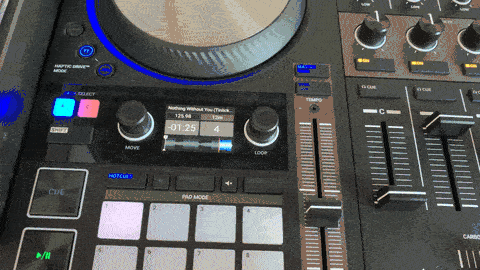 I tried to think of a snappier title than that but it sums it up perfectly. Let’s delve in to what it means.
I tried to think of a snappier title than that but it sums it up perfectly. Let’s delve in to what it means.
Track A is playing at 123BPM. You can hear it playing out of your monitor speakers. On the first of a 4 beat section you hit play on Track B which is playing at 120BPM.
Within seconds you can hear its going too slowly! Is it slipping out of sync really quickly? Or is does it take a few seconds to get worse and worse?
This is the proportionate gap between tempos. So here’s a simple rule
- If the tempo difference is noticeably big, move the pitch fader a large amount.
- If the tempo difference is subtle and takes more time to fall out of sync, move the pitch fader a small amount
Its a simple technique but it works every time. Exactly how big or small the amount you need to move the fader is up to you. Move the pitch up 2 or 3% and see how quickly that helps.
Nudge or drag the track back in to sync between adjustments
If track B is going out of sync you need to change the tempo, but that wont bring the beats back in sync. For this you’ll need to nudge the track on if its going too slowly, or drag the track to slow it down if its going too fast.
This is similar to starting the track bang on a beat. In order to know if your track will fall out of sync again you’ll need get the beats lined up once more.
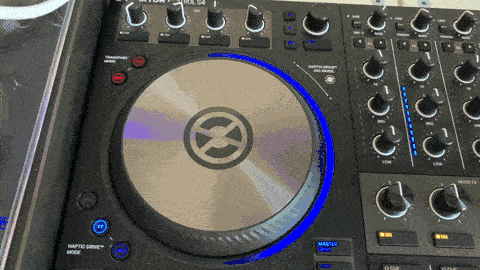 Nudging the track on will depend on the hardware you’re using.
Nudging the track on will depend on the hardware you’re using.
Nudging technique
If your controller has a jog wheel or you’re mixing vinyl you can physically push the edge of the wheel or turntable to temporarily speed up the track. You’re trying to give it a quick nudge so that the beat lagging behind has quickly caught up to the beat that is playing.
Only do this after you’ve changed the tempo, otherwise it’ll just fall out of sync at the same rate it did before.
If you nudged too far or you can hear that Track B is lightly ahead of Track A then you’ll need to drag the track back to match the beat of Track A.
Dragging technique
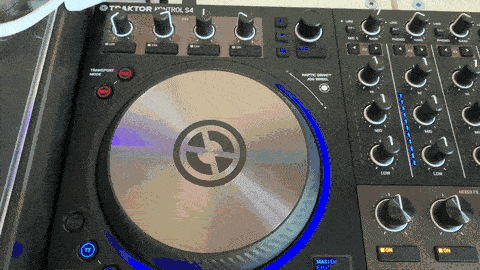 To do this on a jog wheel you physically brush your finger against the wheel or turntable. If the wheel is physically moving you’ll feel some resistance and this will slow your track down temporarily.
To do this on a jog wheel you physically brush your finger against the wheel or turntable. If the wheel is physically moving you’ll feel some resistance and this will slow your track down temporarily.
You should hear the beats come back in to alignment.
If your controller or deck doesn’t have jog wheels then you’ll probably have bitch bend buttons somewhere. These temporarily speed up or slow down your track while holding them.
When you let go the track will play at whatever tempo you’ve got your pitch fader set to. So get used to nudging and dragging with buttons if you need to.
It’s a very different feeling and not as intuitive which is why hardware mimicking traditional vinyl turntables is still a thing!
I’d highly recommend getting controllers or decks with jog-wheels like the Traktor Kontrol S4 Mk 3 which is hands down the best on the market right now for tactile response.
Combining techniques to get beat match quickly
You can beat match pretty quickly with the two techniques above, combining the two by doing the following
- Play track A
- Press play on Track B on the first beat of a 4 beat section.
- Listen to the track and how quickly it falls out of sync.
- If it goes out of sync quickly move the pitch fader a large amount, adding tempo if its too slower or reducing tempo if its too fast.
- Nudge or drag the track back in to sync
- Listen for the track to go out of sync again, it will just but most likely a lot more slowly than before.
- Repeat step 5 onwards
It may sound like I just covered the entire technique of beat-matching in the last chapter. You just keep practicing those steps and repeating the last few right?
Wrong!
The true talent of beat matching is being able to hear whats going wrong and fixing it quickly, refining constantly and keep you two tracks perfectly in sync. There are many factors which can affect how well you can do this. Here’s a few
- The pressure of the environment you’re in (easy at home by yourself, tougher in front of a crowd)
- The style of music you’re mixing (different tempos and styles are harder than others
- The volume and quality of the monitor speakers (more on this later)
- The quality of the hardware you’re using to DJ
- External distractions (people, lights, dancers, other DJs setting up)
There are many reasons your beat matching might slip out of sync and need refinement.
Ever wondered why some DJs look so deep in concentration? This is why.
Listening out for tell tale signs
 Refining and keeping your tracks synced is all about listening out for the signs that your two tracks are slowly slipping out of sync. The important thing is to know which way they are going out of sync.
Refining and keeping your tracks synced is all about listening out for the signs that your two tracks are slowly slipping out of sync. The important thing is to know which way they are going out of sync.
Listen to the kick drums and high hats, Identify with your ears which beat or snare came first, was it the track you’re bringing in? (Track B)
If so track B is going too fast! You need to slow it down! Here’s what you do.
- Drag the track back in to sync with the pitch bend technique, either by dragging the jog wheel or turntable to slow it down, or with the pitch bend buttons on your decks.
- Move the pitch fader a tiny amount to set a new tempo. Just a few 10ths of a beat per minute will do.
- Listen to see if its in sync now or slipping out again
- If it starts to fall out of sync, repeat from step 1
This is essentially our quick tempo find technique in reverse, if you’re in the middle of a mix and both tracks are playing to your audience you’ll want to get the two beats synced again first, then adjust the pitch to make sure it doesn’t happen again.
The art of beat matching really is in this ability to identify which way the track is falling out of sync (too fast or too slow) and rescuing it and refining instantly.
Getting it wrong hurts
This can easily go horribly wrong and if you’re new to beat matching you’ll no doubt experience this plenty of times. The reason your refinement technique is so important is that if you think its going too slow when in actual fact it was going too fast, but you nudge it faster and speed it up anyway, you’ve just made things a whole lot worse!
What was a minor amount of double kick drum now becomes a cacophony of noise with your beats even more out of sync!
You panic! What’s happening? I need to make it better! You nudge on the track more thinking its going to help! OH MY GOD it sounds awful!
You drag the track back in to sync but adjust the tempo too much, now its going the other way. ABORT ABORT!
Welcome to the world of beat matching! Don’t worry, practice really does make perfect. The more you practice this art the better you’ll become and the quicker you’ll be able to rectify any mistakes.
The best DJs in the world can beat match easily and accurately. Be the best!
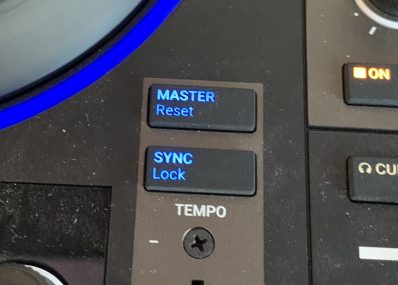 There’s an important subject to bring up here that not many DJs talk about and its a really important one.
There’s an important subject to bring up here that not many DJs talk about and its a really important one.
Here’s the scenario
You’ve spent hours, days, months, years perfecting your beat matching skills
Within 10 – 30 seconds of a track starting you can perfectly sync two tunes. Amazing!
Your DJ hardware shows you the BPM of the two tracks and wow you’re within 0.1 BPM of each other, that’s pretty accurate.
So you ask yourself “If I’m that good? Why don’t I just press sync and get the same result instantly?”
Good question!
And its this question which really is at the crux of whether or not you should be using the sync button. Some say you’re not a true DJ unless you can beat match, others say its fine to use the sync button. There’s a reason for this and the scenario above is that very reason!
So you could be asking yourself right now “If I end up using the sync button anyway, why learn to beat match?”
Another valid question!
But remember there are plenty of times when the sync feature will let you down and can even restrict you in being creative. What are you going to do if it fails? How are you going to get creative if the only way you can sync two tracks is by your computer doing it for you?
Avoid the sync button and learn the skills of beat matching, only once you’ve gained that skill can you evaluate whether you’re the type of DJ that is happy to then use it. And you’ll be safe in the knowledge that if the sync feature does fail (which it most definitely will one day!) you’ll know exactly what to do.
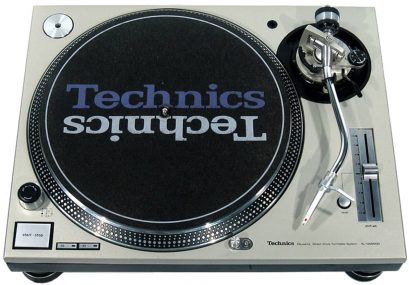 Its worth taking some time out to talk about various formats here because the skill of beat matching most definitely varies between them. So lets start with vinyl.
Its worth taking some time out to talk about various formats here because the skill of beat matching most definitely varies between them. So lets start with vinyl.
While it may be a dying format vinyl is still a DJ favourite, and if you can beat match with vinyl you’ll probably get the hang of the other formats a lot more quickly. I say that partly as its one of the more difficult.
Over the years there have been many turntable manufacturers but there was always one above all others, Technics and the mighty SL12 series. Most notably the SL1200 and SL1210s
The reason these were so good? They had rock solid and highly reliable direct drive motors in them which made beat matching incredibly accurate.
Belt driven turntables were awful for beat matching as there was very little resistance when dragging and it would often speed up too much when nudging. This was never a problem for technics SL turntables!
Since then other turntable manufacturers have improved their hardware and there’s numerous direct drive turntables available.
So assuming you have rock solid direct drive turntables here’s how it will work for you, assuming you have slip-mats on your turntables.
- Play track A on a turntable
- On the other hold track B with your hand and spin the record forwards or backwards to find the first beat
- Move the record forwards in time with the beats of Track A and backwards between beats
- On the first of 4 beats let go of the record and the track will start playing
- If you released perfectly the beats will be in sync but you’ll hear them slowly go out of sync as the BPMs don’t match
- Use the steps in the previous chapters to quickly find the right tempo and refine.
- You’ll need to take the needle back to the start of the track, locate the first beat and launch it again when you want to mix
My preference for nudging is to pinch the spindle in the middle of the turntable and give it a little twist. You’ll notice the dots lit up on the side of the platter will move forwards slightly faster for a moment while you do this.
To drag the track, slowing it down momentarily you can run your finger against the edge of the moving platter. You’ll see the dots will slow down or go backwards when you do this.
Depending on the make of your turntable there will be a varying degree of resistance, practice over and over until you’re used to exactly how much resistance there is and you’ll know just how much pressure you need to apply in order to nudge or drag the track.
Vinyl has always been my favourite for beat-matching as its so hands on. The record is right there in front of you, you can scratch, spin back, move the needle to get back to the start and generally feel very connected to the track you’re playing. DJ-ing bliss!
Controllers is a modern term for a device that is controller a virtual turntable or deck on a computer. These are pretty much industry standard now with the likes of Pioneer, Denon, Native Instruments and others all manufacturing them.
They used to differ in layout and approach but these days they all agree that jog wheels are the way forward.
A jog wheel is a large round movable wheel that is either stationary or motorised to move in time to the playing track.
Its essentially mimicking a traditional turntable giving you the ability to nudge on, drag back and often scratch mix the track you’re beat matching.
Over the years many manufacturers have experimented with this virtual deck feature with varying degrees of success. The issue has always been that traditional turntables gave you plenty of resistance and feedback when you were nudging and dragging. Jog wheels never offered the same accuracy and feedback, until now.
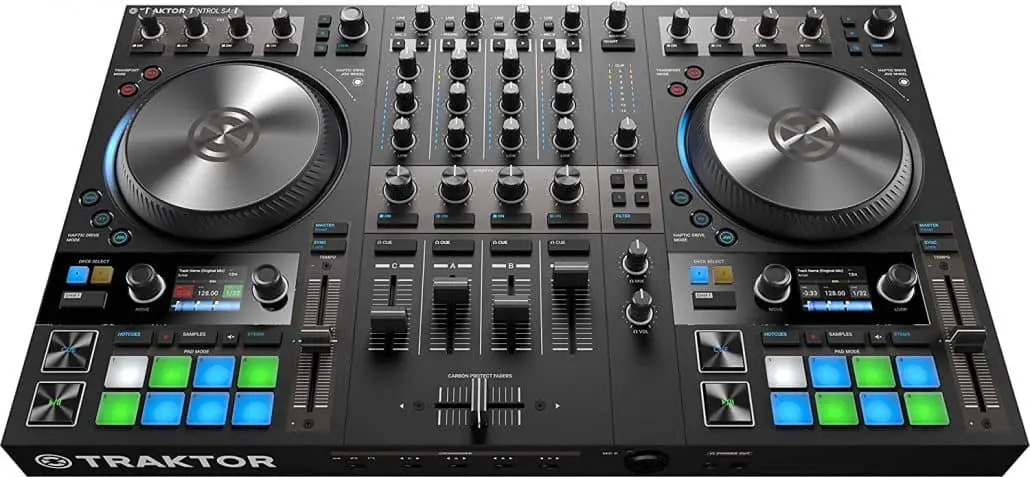
The Kontrol S4 mark 3 from Native Instruments is the first controller with jog wheels that offers haptic feedback and the ability to set your own preferred level of resistance. Its why I love this controller and really feel at home with it. I have the resistance on mine set way up so it feels very much like the SL1210s I have. You can make the jog-wheels spin like turntable platters too while the track is playing, rewinding and scratching like you would on vinyl turntables.
Your controller may have jog wheels so if it does you’ll want to follow the steps outlined in previous chapters and find what works best with the resistance your jog wheels offer.
If you’re using CDJs or similar decks with jog wheels watch this basic video in beat matching.
In my experience they are never as good as traditional direct drive turntables like the SL1210s but the latest breed like the Kontrol S4 Mk3 are getting pretty close. Its made turning off the sync button all the more easier.
Whatever hardware you’re using its most likely controlling software on a laptop. So in essence the laptop is where the beat matching is taking place, the hardware is just giving you tactile tools to make it possible.
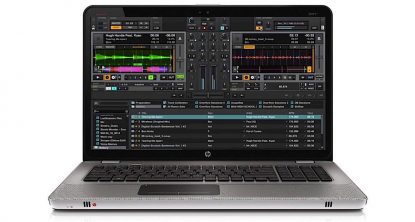 When it was just vinyl turntables or even CDJs there was no BPM counter you could rely on and no visual cues that tracks were close to synced or perfectly synced.
When it was just vinyl turntables or even CDJs there was no BPM counter you could rely on and no visual cues that tracks were close to synced or perfectly synced.
These days there’s plenty of visual cues on the software that take away some of the art form. Traktor Pro 3 has visual cues that show whether the track is too fast, too slow, by how much and BPM counters down to the tenth of a beat per minute.
While these are all very useful and will no doubt get you beat matching in no time, they don’t teach you the skill of beat matching. If anything they stop you listening to the music and make you see the music.
Thats’ not what beat-matching is about.
Ignore the visual cues
I know it’s very tempting to look at them all and use them to help you beat match but don’t. You need to use your ears, identify the sounds and how they’re slipping out of sync, experiment, adjust, learn, repeat and master the art for yourself. With just your ears and your hands.
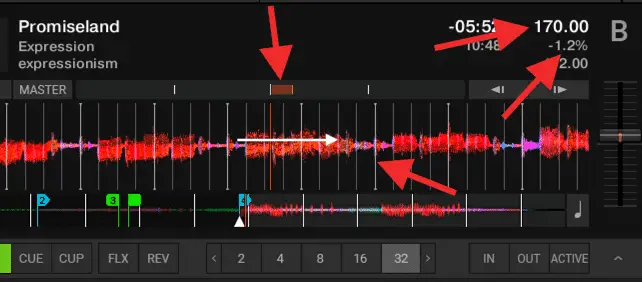
I fully admit I use all of these visual cues and they’re definitely useful tools to help you know that your beat-matching has worked. But thats because I’ve been DJ-ing for many years and am fully confident I have my accurate beat matching skills to fall back on when these visual cues fail me.
They’re only as good as the BPM analysis that the sync feature is using, and as we’ve established already this will fail you! Taking the visual cues along with it. Suddenly you’ll be hearing one thing and seeing something very different.
Trust your ears, adjust with your hands.
Because your ears are so important in this beat matching process you’ll want to be able to identify every sound of track B while Track A is already playing to the crowd.
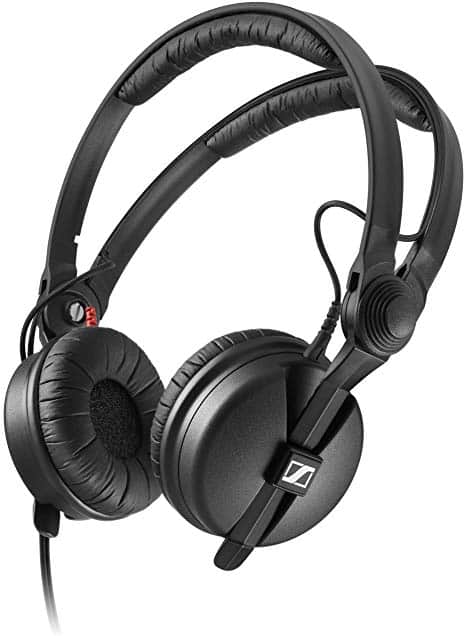 Being able to hear ever crisp high hat, symbol and clap is vitally important, while the bass response for the kick drum and bass lines are all audio identifiers that will help you beat match accurately.
Being able to hear ever crisp high hat, symbol and clap is vitally important, while the bass response for the kick drum and bass lines are all audio identifiers that will help you beat match accurately.
So cheap or low quality headphones are not going to do you any good in mastering beat matching. You may be able to get away with it in the quiet of your own home but it just wont cut it in a nightclub or party venue.
Invest in high quality audio and spend some decent money on professional headphones. Your beat matching skills will benefit greatly and when you ‘re playing to a crowd you’ll have confidence you can hear every little audio cue that helps keep your tracks perfectly in sync.
 Whether you’re in a club or DJing at home you’ll need monitor speakers. While one ear is listening to track B and trying to sync it, the other ear should be tuned to the monitor speaker and the sound that the crowd are hearing.
Whether you’re in a club or DJing at home you’ll need monitor speakers. While one ear is listening to track B and trying to sync it, the other ear should be tuned to the monitor speaker and the sound that the crowd are hearing.
This is why in nightclubs the position and the quality of the monitor speaker are paramount. It serves multiple jobs.
- To project high quality audio of the outbound source, directly at the DJ
- To drown out the sound system facing the crowd and hopefully mask any of the reverb, echo and crowd noise your music will be bathed in by the room you’re in.
You’ll notice club monitor speakers are often large and powerful, despite the fact that they’re just a metre or two max away from the recipient. This isn’t to deafen the DJ but to tick both of those boxes easily. The volume doesn’t need to be high, it just needs to produce very high quality audio very easily.
At home
You don’t need huge speakers at home as there’s no extra sounds and reverbs to down out but you do need good quality audio.
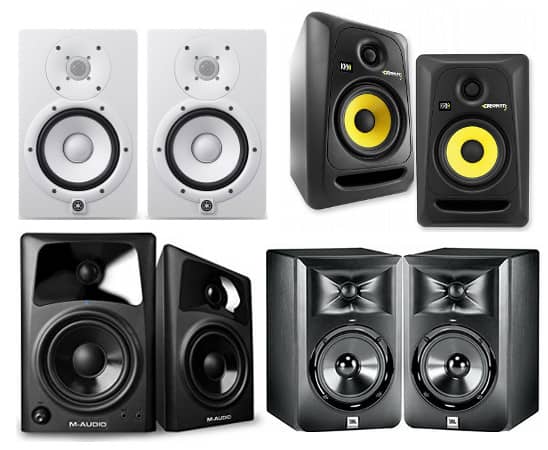 Cheap speakers will be missing the punchy bass and crisp high hats, you’ll end up with a mushy washed out sound that can often blur the various parts of the tracks that you’re trying to identify.
Cheap speakers will be missing the punchy bass and crisp high hats, you’ll end up with a mushy washed out sound that can often blur the various parts of the tracks that you’re trying to identify.
Remember you will have two tracks playing once the mix is in progress, so being able to identify one from the other with monitor speakers is essential.
Invest in something like the Pioneer DM 40 speakers which have the amp built in. This saves space in your home setup and provides good quality audio. The Yamaha HS7 speakers are also highly recommended if you have a separate amp.
If you really mean business and want the best possible monitor experience I’d recommend checking out the KRK RP5 G4 Studio Monitors.
More DJ tips worth reading
We’ll be adding more advanced DJ tips and tricks soon so be sure to sign up to the newsletter.
There are plenty of other ways to improve your DJ skills, check out these articles.
